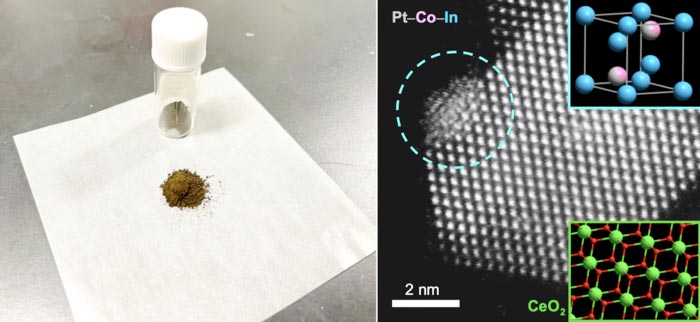New, highly efficient catalyst for propylene production

(Left) The platinum-cobalt-indium catalyst in powder form; (Right) an electron micrograph of the catalyst (structure in top inset) on cerium oxide (CeO2, structure in bottom inset) support (Shinya Furukawa).
Credit: Shinya Furukawa
Researchers have developed an innovative catalyst for the synthesis of propylene, which has potential benefits for the chemical industry and carbon recycling.
Propylene is a colourless, flammable hydrocarbon gas that is an important raw material for the production of a variety of petrochemicals. Due to increasing demand and limited global supply, there is a strong need to develop new, efficient technologies for its production.
Researchers at Hokkaido University have developed an innovative catalyst for the production of propylene that is highly active, selective, stable and utilizes carbon dioxide (CO2) efficiently. Their findings were reported in the journal Nature Catalysis.
One promising technique for producing propylene is a chemical reaction, called oxidative dehydrogenation, that uses CO2 to convert propane gas into propylene by removing hydrogen. However, existing catalysts used to speed up this chemical reaction aren’t very efficient.
“The challenge is to develop a catalyst that will activate both reactants – propane and CO2 – without unwanted side reactions. It also needs to be stable and reusable in the long term,” explains Hokkaido University molecular engineer, Shinya Furukawa.
To achieve this, Furukawa and his colleagues developed a catalyst made from three different metals (platinum, cobalt and indium), each chosen for its specific properties. Platinum was selected as the main active metal because of its ability to break chemical bonds between carbon and hydrogen, enabling the dehydrogenation reaction. Cobalt accelerates CO2 capture and activation, while indium enhances the catalyst’s selectivity. The metals were fixed to a support made from cerium oxide, a compound commonly used in car catalytic converters.
The researchers tested the catalyst’s activity at 550°C and compared the results with existing catalysts. They also performed a mechanistic study to understand the functions of the different components and found the catalyst links the propylene-forming reaction to the deoxygenation of CO2, and ensures the catalytic activity is specific to propane; water and carbon oxides are formed as byproducts. Further, they found that the catalyst increased the reaction rate approximately five fold compared to the typical values reported from other systems. The reaction produced a higher ratio of propylene and utilized more CO2 at 550°C compared to previous catalysts. The catalyst also showed good long-term stability and reusability.
“To date, no other catalyst has been shown to simultaneously exhibit a high catalytic activity, selectivity, stability, and CO2 utilization efficiency. Our multifunctional material meets all these requirements,” says Furukawa.
This study provides new insights into the design of highly efficient catalysts for petrochemical production, and has potential benefits for carbon recycling and greenhouse gas reduction.
Journal: Nature Catalysis
DOI: 10.1038/s41929-021-00730-x
Method of Research: Experimental study
Subject of Research: Not applicable
Article Title: Ternary platinum–cobalt–indium nanoalloy on ceria as a highly efficient catalyst for the oxidative dehydrogenation of propane using CO2
Article Publication Date: 27-Jan-2022
Media Contact
Sohail Keegan Pinto
Hokkaido University
en-press@general.hokudai.ac.jp
Office: +81-11-706-2185
All latest news from the category: Life Sciences and Chemistry
Articles and reports from the Life Sciences and chemistry area deal with applied and basic research into modern biology, chemistry and human medicine.
Valuable information can be found on a range of life sciences fields including bacteriology, biochemistry, bionics, bioinformatics, biophysics, biotechnology, genetics, geobotany, human biology, marine biology, microbiology, molecular biology, cellular biology, zoology, bioinorganic chemistry, microchemistry and environmental chemistry.
Newest articles

GARMI care robot becomes a universal assistant
From skill sets to an overall concept. At the International Conference on Robotics and Automation (ICRA2024) in Yokohama, Japan, geriatronics researchers from the Technical University of Munich (TUM) will present…

Iron-sulfur minerals bear witness to earliest life on earth
Spherical pyrite from black smokers puts Tübingen and Göttingen researchers on the trail of the first microbes that lived billions of years ago. A team of researchers at the Universities…

Wavefunction matching for solving quantum many-body problems
International research team cracks a hard physics problem. Strongly interacting systems play an important role in quantum physics and quantum chemistry. Stochastic methods such as Monte Carlo simulations are a…





















